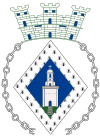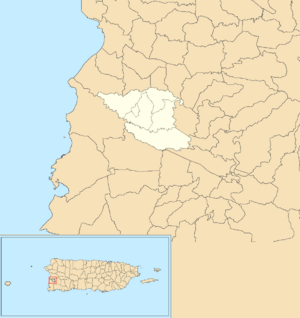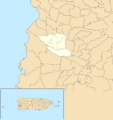Hormigueros, Puerto Rico facts for kids
Quick facts for kids
Hormigueros
Municipio Autónomo de Hormigueros
|
|||
|---|---|---|---|
|
Town and Municipality
|
|||

Basílica Menor de la Virgen de Monserrate
|
|||
|
|||
| Nicknames:
"El Pueblo de Nuestra Señora de la Monserrate", "El Pueblo del Milagro", "Los Peregrinos", "Corazón del Oeste"
|
|||
| Anthem: "Sobre un verde valle de mi linda Borinquén" | |||

Map of Puerto Rico highlighting Hormigueros Municipality
|
|||
| Sovereign state | United States | ||
| Commonwealth | Puerto Rico | ||
| Indigenous settlement | 820 BC | ||
| European settlement | 16th century | ||
| Established | 1692 | ||
| Founded | April 1, 1874 | ||
| Founded by | Giraldo González de la Renta | ||
| Seat | Edificio Modesta Díaz Segarra | ||
| Barrios | |||
| Area | |||
| • Total | 11 sq mi (29 km2) | ||
| • Land | 11 sq mi (29 km2) | ||
| • Water | 0 sq mi (0 km2) | ||
| Population
(2020)
|
|||
| • Total | 15,654 | ||
| • Rank | 68th in Puerto Rico | ||
| • Density | 1,398/sq mi (540/km2) | ||
| Demonym(s) | Hormiguereños | ||
| Time zone | UTC−4 (AST) | ||
| ZIP Code |
00660
|
||
| Area code(s) | 787/939 | ||
| Major routes | |||
Hormigueros is a small town and municipality in Puerto Rico. It is located on the western side of the island. Hormigueros is northeast of Cabo Rojo, northwest of San Germán, and south of Mayagüez.
The town is known by several nicknames. These include "El Pueblo de Nuestra Señora de la Monserrate" (The Town of Our Lady of Monserrate) and "El Pueblo del Milagro" (The Town of the Miracle). It is also called "Los Peregrinos" (The Pilgrims) and "Corazón del Oeste" (Heart of the West). Hormigueros is part of the larger Mayagüez area.
Contents
History of Hormigueros
Early Settlements and Spanish Arrival
The area where Hormigueros is now located was once part of the Guaynia region. This region covered the southwest part of Puerto Rico. Old discoveries show that tribes lived here as early as 820 BC.
When Spanish explorers arrived in the early 1500s, they began to settle the area. A coffin found under the town's main church, the basilica, dates back to before 1600. Historians also mention the Horomico River as a key source of gold during the gold rush of that time.
Becoming a Town
In 1692, the first settlement that would grow into Hormigueros was created. It started as a village connected to San Germán. A person named Giraldo González de la Renta (sometimes spelled Geraldo) founded it.
For many years, Hormigueros was part of San Germán. From 1863 to 1873, the people of Hormigueros asked to become their own independent municipality. Their wish was finally granted on April 1, 1874. Narciso Oller Serra became its first mayor.
Changes in Control
After the Spanish–American War, Spain gave Puerto Rico to the United States in 1898. This happened under the Treaty of Paris of 1898. In 1899, a census by the United States Department of War showed that Hormigueros had a population of 3,215 people.
Later, after the American takeover in 1898, Hormigueros was joined with the town of Mayagüez. This order came from Guy V. Henry. However, some say it was the town's own request. In 1912, Hormigueros became independent again. There were attempts to rejoin it with Mayagüez in 1928–29, but they did not succeed.
Recent Events
On September 20, 2017, Hurricane Maria hit Puerto Rico hard. In Hormigueros, 651 homes were damaged. The strong winds and heavy rain from the hurricane also caused landslides in the area.
Local Stories and Legends
There are many local stories, or folklore, about Hormigueros. One famous legend explains why the town's church, Basílica Menor de la Virgen de Monserrate, became so important. The story tells of the town's founder, Geraldo, whose eight-year-old daughter disappeared. She had "eyes as blue as the turquoise skies."
Fifteen days later, his daughter was found safe and sound. She was not hungry or scared. She happily explained that a kind black woman had helped her. Geraldo and the townspeople believed it was the Virgin of Montserrat. Geraldo promised that because she helped his daughter, the Virgin would be honored forever. Many people heard this tale and began to pray for miracles at that spot. People have been making special trips, called pilgrimages, to the church since the 1600s.
This was not the first miracle Geraldo experienced there. Before this, a wild bull was about to attack him. When he prayed, the bull knelt down, bowed its head, and did not attack. Some versions of this story say the bull's legs actually broke, so it couldn't charge. Because of this, many Catholic believers now walk the steps to the church on their knees as a sign of devotion.
Geography and Climate
Land Features of Hormigueros
The municipality of Hormigueros has three main types of land. The northern part is mountainous, covering about a quarter of the town. It has hills of medium height. The middle section is semi-mountainous, stretching from east to west. This is where downtown Hormigueros is located. The southern part is a flat valley region, covering about 5.6 square miles.
Weather in Hormigueros
Hormigueros has a hot and humid climate. The average temperature usually stays between 72 and 79 degrees Fahrenheit (22 to 26 degrees Celsius).
Divisions of the Town
Like all municipalities in Puerto Rico, Hormigueros is divided into areas called barrios. The main town buildings, central square, and large Catholic church are in a small barrio known as "el pueblo".
Here are the main barrios:
Some other residential areas outside the main downtown are:
- Buenaventura
- San Romualdo Norte
- San Romualdo Sur
- Valle Hermoso Norte
- Valle Hermoso Sur
Smaller Areas (Sectores)
Barrios are further divided into even smaller areas called sectores (which means sectors in English). These sectors can have different names like urbanización, reparto, barriada, or residencial.
Special Communities
Some communities in Puerto Rico are called Comunidades Especiales (Special Communities). These are areas where people might face challenges like social exclusion. In 2014, some of these special communities in Hormigueros included Sector El Hoyo in Jagüitas, Lavadero, Salsipuedes, and San Romualdo.
Culture and Events
Festivals and Celebrations
Hormigueros celebrates its patron saint festival in September. This event is called the Fiestas Patronales Virgen de la Monserrate. It is a religious and cultural celebration. It usually includes parades, games, local crafts, fun rides, traditional food, and live music.
Other festivals and events in Hormigueros include:
- Three Kings' Day Festival – January
- Evening of poetry and music about love and friendship – February
- Cultural Meet – March
- Town Anniversary – April
- Celebration honoring Ruiz Belvis – May
- Evening of poetry and music for mothers – May
- Evening of poetry and music for fathers – June
- Youth Festival – July
- Patron Saint's Festival queen selection – August
- Segundo Ruiz Belvis Marathon – September
- Puerto Rican Culture Day – November
- Lighting of the Christmas tree – The first Saturday after Thanksgiving
- Caroling (Aguinaldos) – December
Tourism and Attractions
To encourage people to visit, the Puerto Rico Tourism Company created a campaign called Voy Turistiendo ("I'm Touring"). It has a passport book and a website. The Hormigueros section lists the Basílica Menor de La Virgen de Monserrate, Casa de los Pelegrinos, and local restaurants as interesting places to visit.
Even though Hormigueros is a small town, it has several places that visitors enjoy:
- Birán Recreational Farm
- Central Eureka (Eureka Sugar Refinery)
- Basilica Menor de la Virgen de Monserrate
Economy of Hormigueros
The economy in Hormigueros is still growing. In the 1980s and 1990s, a company called Allergan, Inc. had a branch in town. This helped the local economy a lot. However, after Allergan left, no other large private companies have opened operations there.
Despite this, Hormigueros has plenty of land, skilled people, and good access for future economic growth. There are two regional airports nearby: Eugenio María de Hostos Airport in Mayagüez and Mercedita Airport in Ponce. Also, the Rafael Hernández International Airport in Aguadilla is about 30 miles away.
Population and Demographics
| Historical population | |||
|---|---|---|---|
| Census | Pop. | %± | |
| 1900 | 3,215 | — | |
| 1910 | 3,887 | 20.9% | |
| 1920 | 4,584 | 17.9% | |
| 1930 | 4,872 | 6.3% | |
| 1940 | 6,098 | 25.2% | |
| 1950 | 6,916 | 13.4% | |
| 1960 | 7,153 | 3.4% | |
| 1970 | 10,827 | 51.4% | |
| 1980 | 14,030 | 29.6% | |
| 1990 | 15,212 | 8.4% | |
| 2000 | 16,614 | 9.2% | |
| 2010 | 17,250 | 3.8% | |
| 2020 | 15,654 | −9.3% | |
| U.S. Decennial Census 1899 (shown as 1900) 1910–1930 1930–1950 1960–2000 2010 2020 |
|||
Hormigueros is one of the less populated municipalities in Puerto Rico. According to the 2000 census, it had 16,614 people. This means there were about 1,510 people per square mile. Since the 1950s, the population has more than doubled.
The 2000 census also showed that most people in Hormigueros (86.0%) identified as Spanish or white. About 4.9% identified as black, and 0.2% as indigenous or other backgrounds.
Symbols of Hormigueros
The municipality has an official flag and a coat of arms.
The Flag of Hormigueros
The town's flag is based on its shield. It is a blue cloth with a white diamond shape in the middle. On top of the white diamond is another blue diamond. Inside the blue diamond is a white globe with a cross, outlined in blue. This globe with a cross stands for royalty and shows Christ's rule over the world. It is a symbol often linked to the Virgin of Montserrat.
The Coat of Arms
The town's shield is a blue diamond shape with a silver border. On the blue background, there is a green hill. This hill represents the Our Lady of Monserrate de Hormigueros Sanctuary, with its silver staircase. The border of the shield has black dots placed evenly. At the top of the shield is a crown shaped like a wall with three towers. These towers have blue doors and windows. The lines between the stones are filled with blue. Two chains surround the shield, starting from the crown and ending below the shield with broken links.
Meaning of the Name
The name Hormigueros means "anthill" in English. The town's name might come from a few ideas. First, it could refer to the large crowds that gathered at the Basilica Menor on September 8 to honor the Virgin of Montserrat. Second, the town's landscape has many hills that look like "anthills" or mogotes. This is why it was once called "Valle del Hormiguero" or "Anthill Valley." Third, the name might come from a Taíno word: Horomico. This word means "río de oro" or "river of gold," because the rivers in the area were important during the gold rush of the Spanish colonization.
Education in Hormigueros
Hormigueros has several public and private schools. The Puerto Rico Department of Education manages public education through the Mayaguez Local Educational Agency (LEA).
The local public schools are:
- Elementary schools
- Escuela Elemental Nueva
- Middle schools
- Ramon Rodríguez Diaz
- High schools
- Segundo Ruiz Belvis
- Second unit (elementary and middle)
- Alfredo Dorrington Farinacci
Higher Education and Talent
Many young adults in Hormigueros (ages 21–35) have a bachelor's degree or higher. This makes the town one of the most educated places in Puerto Rico.
Transportation
Puerto Rico Highway 2 helps people get to Hormigueros from nearby cities like Mayagüez or Ponce. Most other roads in the town are rural.
Hormigueros has a public transportation system that uses public cars. Taxis are also available around the town. There are 16 bridges in Hormigueros.
Images for kids
-
Virgen de La Monserrate at the Museo de las Americas in San Juan, Puerto Rico
See also
 In Spanish: Hormigueros (Puerto Rico) para niños
In Spanish: Hormigueros (Puerto Rico) para niños










